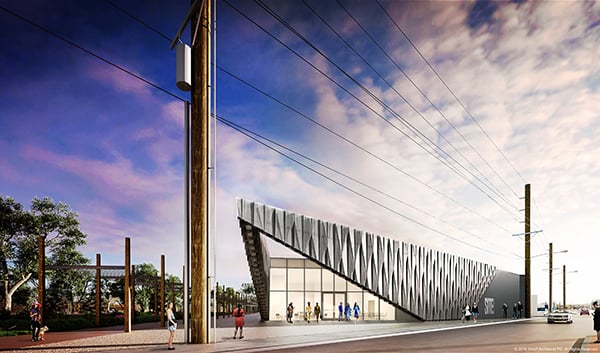
After twenty years, SITE Santa Fe will finally expand its rail yard facility, with a redesign from New York-based SHoP Architects. The renovation will add 15,000 square feet to the existing 21,000-square-foot facility.
The design, unveiled today at a lunch at SHoP Architects’ New York offices, is the result of two years of talks and planning. “We’re good at keeping secrets,” SHoP principal Christopher Sharples told attendees.
Founded in 1995 to host the US’s first international contemporary art biennial, SITE has become a hub of artistic creativity in Santa Fe, hosting works by over 700 artists. As it exists today, however, SITE’s home still bears traces as its former life as a beer distribution warehouse.
Rendering of the lobby of SHoP Architects’ design for SITE Santa Fe.
Photo: SHoP Architects.
“We still have sloped floors in our galleries where I know they were rolling the kegs,” said Irene Hofmann, the museum’s director and chief curator.
According to Hofman, SHoP was selected partially on the strength of the courtyard beach it created as the winner of MoMA PS1‘s Young Architecture program in 2000. This will be the firm’s first museum, although SHoP had done the mock-ups for the New York outpost of Pittsburgh’s Andy Warhol Museum, before the plan was scuttled. SHoP is one of three firms that contributed to the current master plan for the LaGuardia airport redesign.
Rendering of the entrance of SHoP Architects’ design for SITE Santa Fe.
Photo: SHoP Architects.
“We were looking for a firm that was innovative,” Hofman said of SHoP’s selection. SITE is known for its work with emerging artists and artists on the verge of a larger breakthrough, and wanted to work with a firm for whom the expansion would be a project of similar import.
To finance the project, SITE is kicking off the SITE Tomorrow capital campaign, which aims to cover the cost of the expansion and infrastructure improvements, as well as increasing the museum endowment. The renovated building will add a 250-seat auditorium and event space, educational facilities, and a SITElab exhibition space that will allow the institution to host year-round programming.
Rendering of the event space and educational facilities in SHoP Architects’ design for the expanded SITE Santa Fe.
Photo: SHoP Architects.
Both Hofman and the firm were clearly dissatisfied with the original warehouse building, repeatedly referring to it as “a box.” In city with minimal multi-story buildings, the museum was limited in just how much it would be able to innovate.
Though SHoP has done its best to transcend the bare-bones foundation, the plan is already fielding less-than-stellar reviews from City Lab‘s Kriston Capps, who called its “wedge” design, which he compared to the new Broad in Los Angeles, “one of the worst recent trends in architecture.”
Rendering of SHoP Architects’ design for SITE Santa Fe.
Photo: SHoP Architects.
The completed design expands to the edges of the existing plot, sharpening the oblique angles and outfitting the facade at both entrances with a layered corrugated aluminum paneling, inspired by the rail yard’s box cars and the diagonal stripes commonly found in traditional Navajo designs. The walls in between will remain in the original stucco finish, but painted gray.
It’s all designed to take advantage of the visual drama of the Santa Fe desert, capitalizing on the region’s great light. “When you get out there, there’s a different landscape,” explained Sharples, citing the “big sky” and plants with “attitude.”
Rendering of the SITElab in SHoP Architects’ design for the expanded SITE Santa Fe.
Photo: SHoP Architects.
SITE plans to break ground on the project in August 2016, following the opening of its next SITElines biennial. During the duration of the show, which runs until January 2017, work will be limited to the back portion of the building. Construction will begin on the gallery space and front entrance following the completion of SITElines, with the museum scheduled to reopen in the fall of 2017.
“You’re never seen anything like this in Santa Fe before,” promised Hofman.